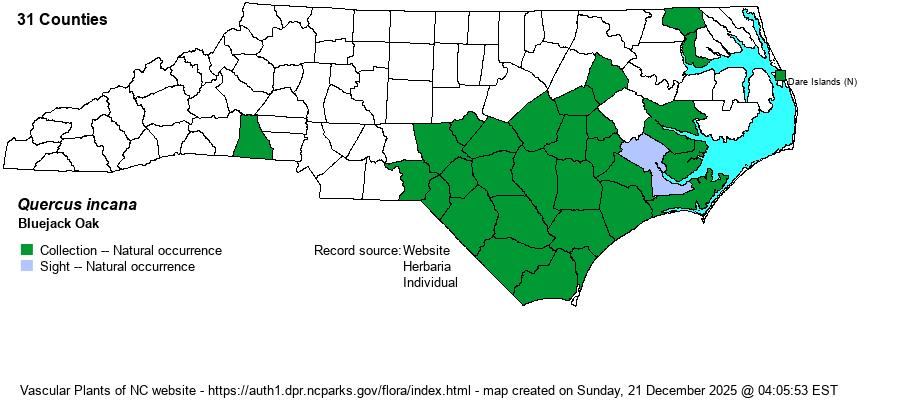| Author | Bartram | |
| Distribution | Throughout the southern 60% of the Coastal Plain, recorded from all counties from Moore, Johnston, and Beaufort southward. However, of spotty occurrence northward in that province to the VA line, certainly absent in a number of such counties. Apparently a valid record for Cleveland County in the southwestern Piedmont, far disjunct from the range in the Carolinas.
A Southern species, ranging north to southeastern VA, south to southern FL and central TX. It does range into the Piedmont or foothills at scattered sites, mainly from AL to southeastern OK.
| |
| Abundance | Common in the southern half of the Coastal Plain, more so in the Longleaf Pine (Pinus palustris) belts in the Sandhills region and in coastal counties from Carteret to Brunswick. Rare to locally uncommon in the northern Coastal Plain; extremely rare, if still extant, in the Piedmont. | |
| Habitat | This species is usually seen growing with Longleaf Pine and several other “scrub” oaks –- Turkey (Q. laevis) and Sand Post (Q. margarettae) –- on sandy soil. In does not do as well on the deeper sands favored by Turkey Oak, but it grows best on loamier and more mesic sands, with somewhat more overall plant diversity than on deeper sands. It is one of the characteristic trees of the Pine/Scrub Oak Sandhill natural community type. |
| Phenology | Flowers in April, and fruits from September to November (of the second year). | |
| Identification | Anyone spending much time in the Sandhills or in other areas dominated by Longleaf Pine should be familiar with this easily identified (when in leaf) species. It is a small deciduous tree, growing to 30-40 feet tall. It has rather small, narrowly elliptical to oblanceolate leaves about 3 inches long and about 1-inch wide, with entire margins and a small bristle tip. It is quite conspicuous even at a distance by its leaf color –- pale blueish-green or grayish-green on the upper surface, and quite pale below, with much hairiness and strong veining visible on that side of the leaf. On some trees, the upper surface is a medium green, but the undersides are then even more contrastingly pale. The only other possible confusion could be with Darlington Oak (Q. hemisphaerica), which has darker green and shinier leaves above and smooth medium green leaf surfaces below. | |
| Taxonomic Comments | None
| |
| Other Common Name(s) | Upland Willow Oak, Sandyjack Oak, Cinnamon Oak | |
| State Rank | S4 [S4S5] | |
| Global Rank | G5 | |
| State Status | | |
| US Status | | |
| USACE-agcp | | |
| USACE-emp | | |

